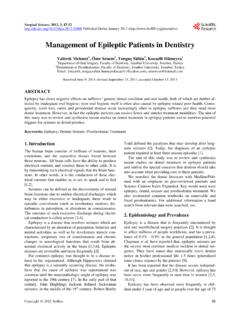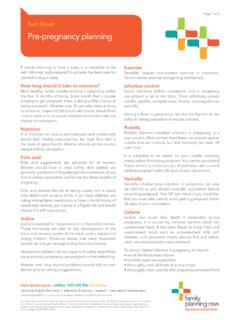Transcription of ANNEX I SUMMARY OF PRODUCT CHARACTERISTICS
1 1 ANNEX I SUMMARY OF PRODUCT CHARACTERISTICS 2 1. NAME OF THE MEDICINAL PRODUCT Keppra 250 mg film-coated tablets 2. QUALITATIVE AND QUANTITATIVE COMPOSITION Each film-coated tablet contains 250 mg levetiracetam. For the full list of excipients, see section 3. PHARMACEUTICAL FORM Film-coated tablet. Blue, 13mm oblong, scored and debossed with the code ucb and 250 on one side. The score line is only to facilitate breaking for ease of swallowing and not to divide into equal doses. 4. CLINICAL PARTICULARS Therapeutic indications Keppra is indicated as monotherapy in the treatment of partial onset seizures with or without secondary generalisation in adults and adolescents from 16 years of age with newly diagnosed epilepsy.
2 Keppra is indicated as adjunctive therapy in the treatment of partial onset seizures with or without secondary generalisation in adults, adolescents, children and infants from 1 month of age with epilepsy. in the treatment of myoclonic seizures in adults and adolescents from 12 years of age with Juvenile Myoclonic Epilepsy. in the treatment of primary generalised tonic-clonic seizures in adults and adolescents from 12 years of age with Idiopathic Generalised Epilepsy. Posology and method of administration Posology Partial onset seizures The recommended dosing for monotherapy (from 16 years of age) and adjunctive therapy is the same; as outlined below.
3 All indications Adults ( 18 years) and adolescents (12 to 17 years) weighing 50 kg or more The initial therapeutic dose is 500 mg twice daily. This dose can be started on the first day of treatment. However, a lower initial dose of 250 mg twice daily may be given based on physician assessment of seizure reduction versus potential side effects. This can be increased to 500 mg twice daily after two weeks. Depending upon the clinical response and tolerability, the daily dose can be increased up to 1500 mg twice daily. Dose changes can be made in 250 mg or 500 mg twice daily increases or decreases every two to four weeks.
4 3 Adolescents (12 to 17 years) weighing below 50 kg and children from 1 month of age The physician should prescribe the most appropriate pharmaceutical form, presentation and strength according to weight, age and dose. Refer to Paediatric population section for dosing adjustments based on weight. Discontinuation If levetiracetam has to be discontinued it is recommended to withdraw it gradually ( in adults and adolescents weighing more than 50 kg: 500 mg decreases twice daily every two to four weeks; in infants older than 6 months, children and adolescents weighing less than 50 kg: dose decrease should not exceed 10 mg/kg twice daily every two weeks; in infants (less than 6 months): dose decrease should not exceed 7 mg/kg twice daily every two weeks).
5 Special populations Elderly (65 years and older) Adjustment of the dose is recommended in elderly patients with compromised renal function (see Renal impairment below). Renal impairment The daily dose must be individualised according to renal function. For adult patients, refer to the following table and adjust the dose as indicated. To use this dosing table, an estimate of the patient's creatinine clearance (CLcr) in ml/min is needed. The CLcr in ml/min may be estimated from serum creatinine (mg/dl) determination, for adults and adolescents weighing 50 kg or more, the following formula: [140-age (years)] x weight (kg) CLcr (ml/min) = ---------------------------------------- - (x for women) 72 x serum creatinine (mg/dl) Then CLcr is adjusted for body surface area (BSA) as follows.
6 CLcr (ml/min) CLcr (ml/ m2) = ---------------------------- x BSA subject (m2) Dosing adjustment for adult and adolescent patients weighing more than 50 kg with impaired renal function: Group Creatinine clearance (ml/ ) Dose and frequency Normal Mild Moderate Severe End-stage renal disease patients undergoing dialysis (1) 80 50-79 30-49 < 30 - 500 to 1500 mg twice daily 500 to 1000 mg twice daily 250 to 750 mg twice daily 250 to 500 mg twice daily 500 to 1000 mg once daily (2) (1) A 750 mg loading dose is recommended on the first day of treatment with levetiracetam.
7 (2) Following dialysis, a 250 to 500 mg supplemental dose is recommended. For children with renal impairment, levetiracetam dose needs to be adjusted based on the renal function as levetiracetam clearance is related to renal function. This recommendation is based on a study in adult renally impaired patients. 4 The CLcr in ml/ m2 may be estimated from serum creatinine (mg/dl) determination, for young adolescents, children and infants, using the following formula (Schwartz formula): Height (cm) x ks CLcr (ml/ m2) = ------------------------------------ Serum Creatinine (mg/dl) ks= in Term infants to 1 year old; ks= in Children to less than 13 years and in adolescent female.
8 Ks= in adolescent male Dosing adjustment for infants, children and adolescent patients weighing less than 50 kg with impaired renal function: Group Creatinine clearance (ml/ m2) Dose and frequency (1) Infants 1 to less than 6 months Infants 6 to 23 months, children and adolescents weighing less than 50 kg Normal 80 7 to 21 mg/kg ( to ml/kg) twice daily 10 to 30 mg/kg ( to ml/kg) twice daily Mild 50-79 7 to 14 mg/kg ( to ml/kg) twice daily 10 to 20 mg/kg ( to ml/kg) twice daily Moderate 30-49 to mg/kg ( to ml/kg) twice daily 5 to 15 mg/kg ( to ml/kg) twice daily Severe < 30 to 7 mg/kg ( to ml/kg)
9 Twice daily 5 to 10 mg/kg ( to ml/kg) twice daily End-stage renal disease patients undergoing dialysis -- 7 to 14 mg/kg ( to ml/kg) once daily (2) (4) 10 to 20 mg/kg ( to ml/kg) once daily (3) (5) (1) Keppra oral solution should be used for doses under 250 mg, for doses not multiple of 250 mg when dosing recommendation is not achievable by taking multiple tablets and for patients unable to swallow tablets. (2) A mg/kg ( ml/kg) loading dose is recommended on the first day of treatment with levetiracetam. (3) A 15 mg/kg ( ml/kg) loading dose is recommended on the first day of treatment with levetiracetam.
10 (4) Following dialysis, a to 7 mg/kg ( to ml/kg) supplemental dose is recommended. (5) Following dialysis, a 5 to 10 mg/kg ( to ml/kg) supplemental dose is recommended. Hepatic impairment No dose adjustment is needed in patients with mild to moderate hepatic impairment. In patients with severe hepatic impairment, the creatinine clearance may underestimate the renal insufficiency. Therefore a 50 % reduction of the daily maintenance dose is recommended when the creatinine clearance is < 60 ml/ m2. Paediatric population The physician should prescribe the most appropriate pharmaceutical form, presentation and strength according to age, weight and dose.














